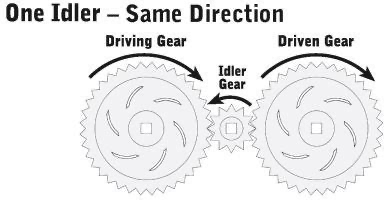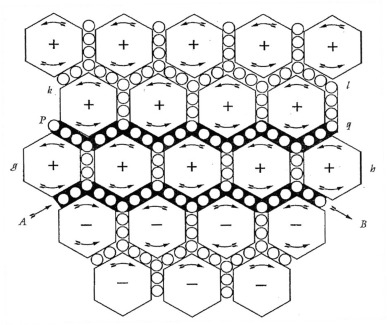14.4. The Jelly of the Ether#
Maxwell, along with virtually every natural scientist of the time, believed that light propagated as an undulation–a waving–of a substance that was everywhere: the “ether,” or more specifically for light, the “Luminiferous Ether.” It makes sense in a world where visible things are mechanical and if light is a wave, then something had better be waving.
So he made a model. Which evolved and which he then abandoned like a scaffolding that might hold up a new building until it’s no longer required and the building can stand on its own. It’s archaic, and frankly a little weird and so I’ll only sketch the idea.
Maxwell’s approach:
“I propose now to examine magnetic phenomena from a mechanical point of view, and to determine what tensions in, or motions of, a medium are capable of producing the mechanical phenomena observed.
“The author of this method of representation does not attempt to explain the origin of the observed forces by the effects due to these strains in the elastic solid, but makes use of the mathematical analogies of the two problems to assist the imagination in the study of both.”
He was dealing with the odd notion that magnetic forces appeared perpendicular to the source of the force itself. That’s a little strange, right? If you push north on that red VW, you don’t expect it to move to the east. But that’s how things seemed to happen for magnetic forces. Remember Faraday’s moving magnet and the coil: move the magnet through the coil and the currents flow perpendicular to the magnet’s field, around the coil. Align two wires with currents flowing in them and the force that is produced is perpendicular to both the direction of the currents and to the direction of the magnetic field that one of the wires produces in the location of the other wire.
What, he thought, works that way in a mechanical environment? Spinning things. The axis of rotation of the earth is through the poles, but the bulge at the equator due to the centripetal force at that farthest distance from the axis is less and so the earth bulges at the equator–perpendicular to the spin axis.
So he built a model in which the magnetic field was due to little spheres of rotating masses. That they be massive was required because he needed them to bulge. (He presumed that the masses were so small as to not be apparent in real life–it’s a toy model, after all.) If the little spheres are everywhere, then the bulging of neighbors would create a pressure that’s perpendicular to their spinning axis.
But that creates a problem–ah, and an opportunity. Won’t the spinning of one row of spheres rub against the spinning of an adjacent row? Well it would, but what mechanical engineers do when there are adjacent spinning gears–and what Aristotle did with his crystalline spheres that supported the planets–is to add a row of “idler gears” which themselves rotate and translated that motion to the other row.
Here’s a set of drive gears and their shared “idler gear.”

Maxwell’s were not gears, per se, but spheres with adjacent friction to transmit motion. And what are they? Electrical charges in currents.
Here’s a picture from Maxwell’s eventual publication, On Physical Lines of Force The Theory of Molecular Vortices applied to Electric Currents in 1861 (part two of a four part series of papers, 1861-1862).

The two lines AB and PQ are physical, metal wires which consist of electrical charges that are free to flow. He imagines a voltage is applied between A and B and that these little spheres in the wires start to move. But, they’re idler spheres and so the cause the “molecules” in space or a material to begin to rotate on either side of AB. That’s the magnetic field surrounding a current-carrying wire and his picture is a slice through the spheres with their rotational axes pointing out or in.
Faraday’s induction: But there’s another wire just sitting there minding it’s own business between P and Q. That adjacent, now rotating set of molecules above AB are rotating and they cause the charges in the wire PQ to begin to move from Q to P. That’s an induced current–the current in AB caused a field which caused a current in PQ and he’s explained Induction. (Since a current creates a magnetic field, it’s a stand-in for the bar magnet in our oft-used example of creating a current in a loop in its presence.)
Furthermore, the rotating molecules are springy and that springiness he was able to imagine playing the role of the attraction and repulsion of electric and magnetic fields from static sources–attributing to space the ability to store energy (the elasticity of the springiness). So his model covers Faraday discoveries 1-3.
There’s a lot of work done by this little mechanical model of space.
In the course of four papers between 1861 and 1865 eventually the mechanical model went away, and the mathematical description remained. To this day, with one more additional suggestion that made all the difference.
But his model also predicted something that nobody’d considered before.
First, an interlude.